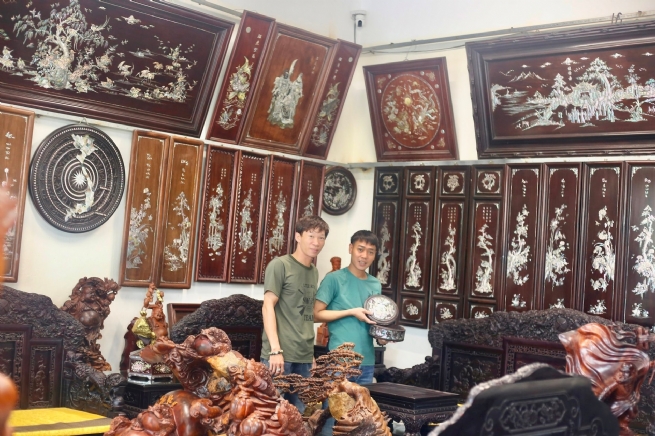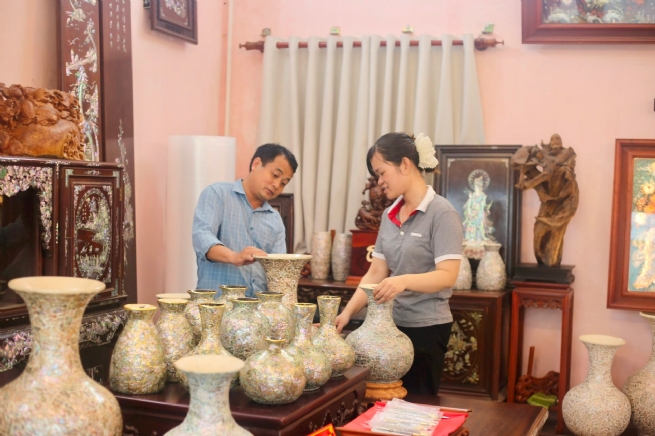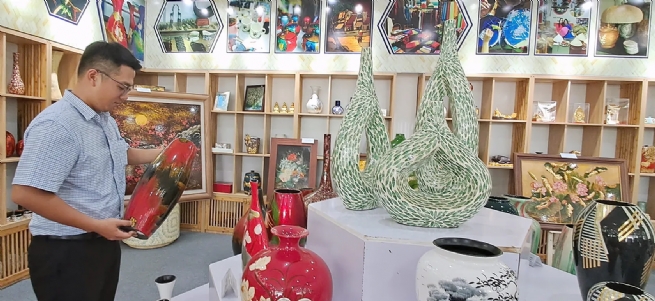The One Commune One Product (OCOP) program and Hanoi handicrafts not only meet domestic demand but also have export potential thanks to their aesthetic value, advanced manufacturing techniques, and high practicality.

This special section is supported by Hanoi Coordination Office of the
In Chuyen My village, known as the ancestral land of traditional mother-of-pearl inlay in southern Hanoi, it is common to see artisans working diligently at the inlay table, carefully attaching each small snail piece and shiny mother-of-pearl segment to the wooden surface. At the center of this activity, Vu Van Dinh's production facility stands out as a prominent highlight of the craft commune. With outstanding product lines including multi-purpose mother-of-pearl inlaid boxes, lacquer disc paintings, and intricately inlaid wooden vases, his facility has secured a strong position in the hearts of consumers, particularly for high-end gifts and souvenirs. Notably, all mother-of-pearl and shell inlay materials are carefully selected and imported from Singapore, India, and other sources.
According to Vu Van Dinh, participating in the OCOP program has marked a major turning point in product development. “Since we began creating products associated with OCOP, we have become more attentive to quality, design, and the cultural story behind each item. The city’s support in promoting trade has helped the village’s products reach more customers, particularly in the high-end gift market,” Dinh shared.

Each handmade product at Vu Van Dinh is more than an item or decoration; it is a work of art crafted with meticulousness, ingenuity, and the artisan’s love. Among these unique products, the line of mosaic portraits of leaders vividly demonstrates the pinnacle of technique and talent of Chuyen My craftsmen. The mosaic portraits of President Ho Chi Minh, General Vo Nguyen Giap, and others are not only rendered with accurate spirit and lines but also convey solemnity and charisma through the seemingly simple mother-of-pearl and snail materials. In particular, depicting a leader’s face using naturally lustrous materials like mother-of-pearl while maintaining both intimacy and majesty is a challenge that few artisans can master.
In addition, the mother-of-pearl inlaid vase, a popular interior decoration item, showcases the most challenging inlay techniques on curved surfaces. Each lotus pattern, dragon and phoenix motif, and winding landscape is expertly inlaid, reflecting the mastery of the craftsman. Every vase represents a miniature world where the essence of materials and techniques comes together to create a luxurious and refined beauty.
In the context of integration and development, the handicraft industry has significant opportunities to expand into international markets but also faces numerous challenges, including the decline of traditional crafts, a shortage of skilled human resources, competitive pressures, and environmental concerns. Therefore, a comprehensive assessment of these opportunities and challenges is essential to guide sustainable development strategies for the period 2025-2030.

In addition to their economic value, craft villages also preserve cultural heritage, attract tourists, and provide livelihoods for approximately 800,000 local workers, with an average per capita income of over VND50 million per year. However, in the current context of integration, Hanoi’s handicraft villages face numerous challenges.
To expand the market, experts believe that, in addition to promoting the trade of OCOP products, handicrafts, and craft villages, it is necessary to provide artisans with design and market consulting and develop products in line with international trends. When the links in the value chain, including production, distribution, and consumption, are closely connected, OCOP products, handicrafts, and craft villages in Hanoi will have greater opportunities to reach both domestic and international markets.
Nguyen Anh Duong, Deputy Director of the Hanoi Department of Industry and Trade, stated that handicraft products not only play a vital role in rural economic development but also serve as a symbol of Hanoi. In addition to improving human resource quality and developing branded products, it is necessary to support the creation of individual brands, establish geographical indications, organize fairs and exhibitions both domestically and internationally, and promote the OCOP program.
In particular, it is essential to support businesses and craft villages in accessing e-commerce platforms and to implement policies that encourage the younger generation to continue their ancestral traditions. Accordingly, policies should also recognize and honor artisans, providing financial support and improving working conditions. Trade promotion must be strengthened through the organization of exhibitions and handicraft fairs to bring products closer to consumers and expand their presence in international markets.
By Ngoc Dan, Vietnam Business Forum
|
This special section is supported by Hanoi Coordination Office of the New Rural Development Program |